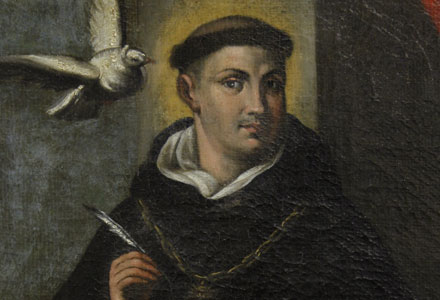
It can be difficult to convince people to read Thomas Aquinas, arguably the greatest medieval Western philosopher. And let’s face it, the impediments are real. First, there is our culturally inherited caricature of the Middle Ages as an interregnum of intellectual darkness during which all the knowledge acquired in the ancient world was lost or actively suppressed. The fact that one is likely to get advanced degrees in philosophy without ever having read or discussed a single medieval philosopher (or even caught a whiff of medieval history!) only further entrenches these ignorant and hackneyed clichés. Second, there is the fact that Aquinas is difficult to understand. Although he famously writes at the outset of his oversized Summa Theologiae that it is intended for “beginners” one needn’t get more than a few paragraphs in to wonder just how out of touch Thomas must have been with an average student! Frankly, it’s impossible to understand much of what he is up to without some grasp of Aristotelian metaphysics. And unlike Plato or Augustine, Aquinas’s prose is technical and bereft of literary flourishes—he sticks to arguments that adhere to the rigors of logic as he understood it, which leaves some readers cold. Finally, there is the persistent and pervasive sense that it is sufficient to read Aristotle, and Aquinas is simply not worth the bother.
In an earlier post (“Why Aquinas?”), I gave some initial reasons to think that Aquinas is worth the effort. But I’d like to go further today and argue that the form and structure of the Summa is an exemplar of philosophical inquiry quite generally, and that this literary form points us not only to the true value of philosophy, but also to a better understanding of its place as the cornerstone of the liberal arts.[1]
The Summa (an unfinished work!) is divided into 512 topics (quaestiones), which are subdivided into 2, 668 articles (articuli). The fewest articles that Thomas devotes to a single topic is two, the most he devotes to a single topic is seventeen. All articles that fall under a topic also begin with a question, the determination of a further problem relating to the main topic to be addressed. For example, under the topic of Free Will, Aquinas asks: (1) Whether man has free will? (2) Whether free will is a power? (3) Whether free will is an appetite? (4) Whether free will is a power distinct from the will? But notice that not any old question will do to begin an article—it must be framed so as to admit to opposing answers, a pro and a con. Such questions are, according to Otto Bird, “formally dialectical.” A dialectical question is distinguished from all others by the fact that it leaves one free to take either side of a contradiction. [Aristotle, De Interpretatione, 20b23-30] Questions of the form, “What is the nature of X?” are not dialectical, because they admit of only one answer. For that reason, Aquinas avoids them.
Having posed a question that admits of opposing answers, which demonstrates that we are in the realm of a disputation, Aquinas proceeds to give arguments for both sides. He uses the language of “sic proceditur” which is best translated as “thus it is argued or disputed.” This signals to the reader that an answer will not simply be given to the reader, but that real work needs to be undertaken in order to reach a resolution to the problem at hand. Notably, Aquinas always begins by giving the argument for the side he will ultimately oppose, called “objections” and he usually presents three or four of them at the start. In presenting objections to his own view, Aquinas is not simply engaging in conceptual analysis or surveying logical space. Rather, at this stage he is consulting the “authorities,” those whose opinions have been handed down to us as worthy of serious engagement. For Aquinas, these authorities are the Patristics (the “Fathers” of the early Church, both Latin and Greek), other medieval philosophers, including Jews (Maimonides) and Arabic philosophers, (Avicenna and Averroes), and of course pagan thinkers like Plato, Cicero, and most especially Aristotle, who carries such weight and authority with Aquinas that he simply refers to him as “the Philosopher.”
Following the initial set of arguments or objections we make our way to the sed contra, the arguments for the contrary view, and the one that Aquinas will ultimately favor. Having looked at arguments on both sides, the reader finds herself in a state of indetermination. She is ready to move on to the next part of the article, known as the respondeo, (“I respond thus”). The respondeo contains Aquinas’s own considered view and his arguments for it—it is his resolution of the problem at hand. The respondeo is clearly the heart of the entire article, but certainly not the whole of it. It would be a huge mistake to skip what proceeds and follows it.
It is crucial to the form of the article that it does not end with Aquinas’s arguments in favor of his own view. Instead, the article draws to a close by revisiting the initial arguments opposing those given in the respondeo. These are called the “replies to the objections” and Aquinas painstakingly goes through each objection and offers a detailed response to it. Only once his opponent has been given his full due does Aquinas move on to the next question.
The value of this method, which we may call “dialectical disputation” is that it forces the reader to actively participate in a discourse that will allow her to learn by seeing for herself how the resolution to the problem has been arrived at. In fact, the article format itself is a model of how discourse ought to operate: one begins one’s inquiry with an open ended, dialectical question, carefully considers the best arguments from renown thinkers on both sides, and then works up one’s own arguments for the view one favors. Having grasped the reasons for one’s own conclusion, one must give one’s opponent full due by responding to him in detail.
One sees that Aquinas’s method is the antithesis of what we have been conditioned to expect from a medieval thinker—it is neither dogmatic (in the negative sense), nor insular, nor ignorant, nor closed-minded. The value of the method displays the value of philosophy itself: the mind’s active and open search for truth, that good in which the mind naturally rests. This search is demanding, and it requires that we consider propositions and arguments we find deeply offensive and problematic (for instance, Aquinas constantly entertains arguments against the basic tenets of his own faith throughout the Summa). The reason Thomas must consider opposing views is that some of the best minds he knows of have reached conclusions that are opposed to his own deeply held convictions—convictions that shape his identity as a Christian friar and structure his way of life.
Aquinas’ method shows that the pursuit of truth takes diligent effort, courage, and charity. But the pursuit of truth is worth the risks and the strain, because it allows us to attain the good of the intellect, a crucial component of the good life. For this reason philosophy—the pursuit of wisdom—is the center of a liberal arts education, which, by contrast with the servile arts, aims at nothing other than human freedom and fulfillment.
Jennifer A. Frey is a principal investigator with Virtue, Happiness, and the Meaning of Life.
Further Reading
Otto Bird. “How To Read An Article of the Summa.” New Scholasticism 27(1), 1953.
McGinn, Bernard. Thomas Aquinas’s Summa Theologiae: A Biography. Princeton: Princeton University Press, 2014.
Torrell, Jean-Pierre, O.P. Aquinas’s Summa: Background, Structure, and Reception. Washington, D.C.: Catholic University of American Press, 2005.
[1] For my own understanding of the structure and importance of this format, I am deeply indebted to Otto Bird’s “How To Read An Article of the Summa” New Scholasticism 27 (1), 1953. Otto Bird was the founder of Notre Dame’s Program of Liberal Studies, a “great books” program that focuses on a traditional liberal arts education.





